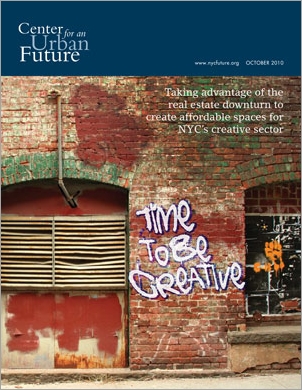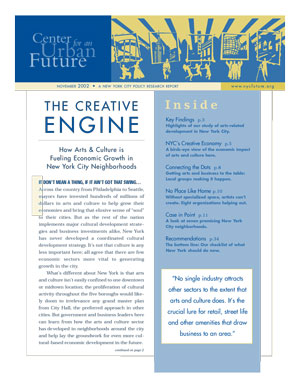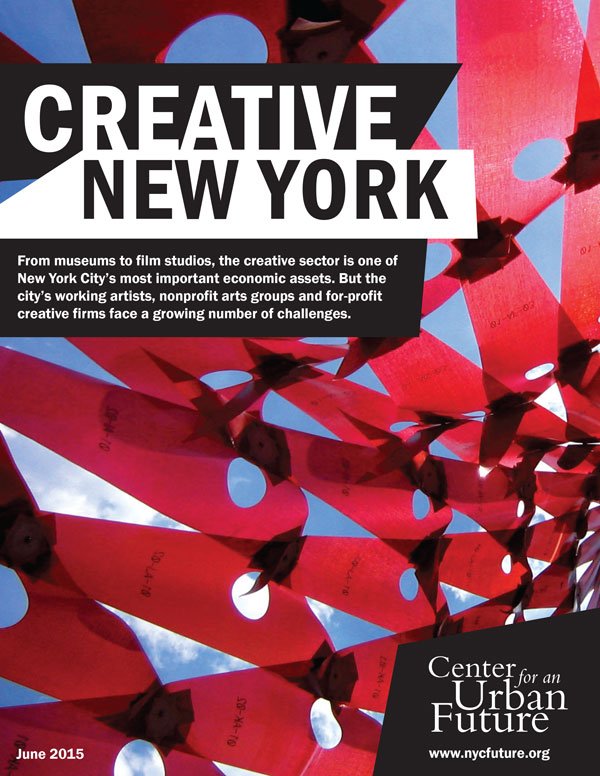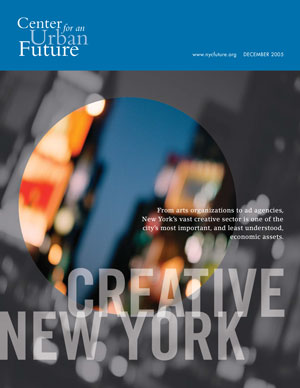This is an excerpt. Click here to read the full report (PDF).
Speaking in 2006 about the role of creative industries from film and graphic design to publishing and the performing arts, Mayor Bloomberg aptly characterized the creative sector as New York City’s “heart and soul.” But in the wake of the gravest economic crisis in a generation, New York needs the creative sector to assume an even more critical role in the city’s economic future.
The creative sector stands out as one of the best vehicles for both reigniting and diversifying the city’s economy, two important goals at a time when New York’s unemployment rate still stands at 9.3 percent and traditional drivers like finance are expected to experience sluggish growth in the years ahead. Though creative industries have not been immune to the effects of the Great Recession, their prospects for future growth are brighter than many other sectors in today’s idea-driven economy. Indeed, creativity and design is arguably the city’s greatest competitive advantage in an era where fierce global competition is causing industries from finance to manufacturing to add a disproportionate share of their new jobs overseas.
While the creative sector holds considerable potential, its growth in New York is far from assured. The real estate boom of the past decade has made the city increasingly unaffordable as a place for artists to live, work, rehearse and perform. At the same time, countless artists and nonprofit arts organizations—the key building blocks of New York’s larger creative sector—are now reeling from an epic crisis brought on by the economic downturn. And all of this is occurring as numerous American cities have been stepping up their efforts to recruit creative people.
The ongoing economic and real estate downturn presents a golden opportunity to strengthen the creative sector for the long term. The dramatic drop in real estate prices, in particular, offers a rare chance to re-use or redevelop real estate in ways that help address the serious space problems facing artists, arts organizations and creative enterprises. There is significant precedent for this: previous downturns have produced some of the most innovative and imaginative real estate development projects and policy proposals in the city’s history—many of which specifically benefited nonprofits and those in the arts.
New York’s policymakers, grantmakers and business leaders must take bold steps now to maintain the city’s creative advantage and fulfill this sector’s potential for growth. This report provides a blueprint for what should be done.
* * *
Funded by the Rockefeller Foundation and based on nearly a year of research, our report argues that this moment—with the economy in distress and arts groups themselves facing an almost unprecedented convergence of crises—is precisely the right one to dramatically step up efforts on behalf of New York City’s creative sector.
In the pages that follow, we provide city policymakers, philanthropic officials and business leaders with a set of 17 recommendations to strengthen the creative sector—most, but not all, of which involve taking advantage of the downturn in the real estate market to create new spaces for artists, arts organizations and creative entrepreneurs. Our blueprint is informed by more than 75 interviews with artists, leaders of arts organizations, executives of creative businesses, real estate developers, grant-makers, economic development experts and urban planners.
There are compelling reasons why city policymakers should take advantage of the downturn to strengthen the creative sector. The most obvious is economic self-interest. The nine industries we consider part of the creative sector—advertising; film and video; broadcasting; publishing; architecture; design; music; visual arts; and performing arts—cumulatively employ more than eight percent of all workers in the city. Combined, they grew at a faster clip than the rest of the economy in the early part of this decade. Some creative fields, such as film and TV production and the performing arts, even added a significant number of jobs in the past year, while most parts of the economy were receding.
Moreover, in today’s global economy, where fewer and fewer things are actually made in high cost urban areas and when a growing number of cities across the world are fighting for market share in high-end sectors like financial services, the Big Apple’s future competitive advantage will increasingly depend on maintaining its status as a creative hub. “The emergence of the creative economy will, at least in terms of job growth if not in terms of revenue, be more of a driver than financial services in the future of the city,” says Carl Weisbrod, past president of real estate for Trinity Church and former head of the New York City Economic Development Corporation. “Creative businesses run the gamut from small nonprofits to large multinationals, but they’re tied to each other. What they’re all drawing from and what is the essence of the city is the great talent pool. Ultimately, the city should be focused on how to attract and retain that talent.”
The question of what New York can do to attract and retain creative talent is a central focus of this report. Our recommendations are premised on a belief, informed by the dozens of interviews we conducted, that New York is not immune to losing its status as the pre-eminent destination for writers, designers, visual artists, performers and other creative professionals. In fact, New York’s creative edge arguably is more at risk today than ever before.
There has not yet been an exodus of creative individuals from the city, but it is undeniable that many artists have given up on New York, reluctantly, for cheaper locales such as Philadelphia, the Hudson Valley and Berlin. While New York continues to draw creative people from around the world, the city is no longer the only natural destination for artists, writers and designers. More American cities now have the cultural amenities that creative people demand and a growing number of regions have developed policies to attract creative talent. The “pull” efforts of other areas have coincided with a strong local “push” factor: rapidly escalating real estate prices in the past decade that have made it exceedingly difficult for artists to live and work here.
“I believe this city risks losing its working community of artists,” says Ted Berger, past president of the New York Foundation for the Arts. “That’s a problem for a city that economically needs this community here. We are in an acute situation for work space and live space for individual artists.”
Some local arts experts believe that younger and more innovative artists may already be bypassing New York for other, more affordable cities. “The younger generation [of artists] is unable to come here and is no longer influencing the culture of New York City,” says Anne-Brigitte Sirois, the founder of Art State, a Manhattan-based firm that advances the development of arts spaces. “If nothing is done, New York will become like Washington, DC—an institutional place with nothing interesting occurring.”
Space issues are not the only immediate threat to New York’s creative sector. Another problem is that a growing number of the city’s theater companies, dance troupes and other nonprofit arts groups are facing serious threats to their survival because of a perfect storm of economic pressures caused by the downturn. Organizations in New York’s nonprofit arts sector traditionally have drawn from multiple sources of revenue, including government support, charitable contributions and gate receipts or sales. Under normal circumstances, when one revenue stream dries up—for example, a philanthropic funder chooses to discontinue its giving, or direct income dips for reasons outside of an organization’s control—the others provide enough of a cushion that, while an organization might endure some belt-tightening, its survival is not in question. The threat to New York City’s nonprofit arts organizations in this downturn is that every one of these revenue streams is under severe strain.
While arts groups clearly are not the only ones suffering in this downturn, the sheer number of arts organizations that are fighting for survival has implications for the city’s economy. That’s because these groups provide a key foundation for the larger creative sector. Indeed, the presence of such a varied group of small and mid-sized arts groups makes New York singularly attractive to creative people from around the globe.
To this point, only a handful of arts groups have shut their doors entirely. But most organizations, large and small, have had to make painful cuts—from scaling back exhibitions and reducing the number of performances to eliminating staff. This May, the Alliance for the Arts published a report finding that 42 percent of the cultural groups they surveyed anticipated cancelled or postponing programs this year, while 60 percent of the organizations said they were reducing their budgets. “So many groups are hanging on by their fingernails,” says Eugenie Cowan, executive director of NYC Performing Arts Spaces.
Individual artists are also struggling, even more so than normal. In 2009, the average unemployment rate for all artists nationwide was 9.5 percent, higher than the unemployment rate of the civilian workforce (8.6 percent). Unemployment among artists rose faster than for other workers; between 2008 and 2009, the artist unemployment rate climbed by 4.3 percentage points—a full point higher than the increase to the overall unemployment rate over the two-year recessionary period.5 With a disproportionate share of the nation’s artists, New York’s creative community is undoubtedly feeling much of this pain.
Many of those we interviewed applaud the Bloomberg administration for improving upon what was already arguably the nation’s most supportive local arts policy. The city’s Department of Cultural Affairs (DCA) has a larger budget than the National Endowment for the Arts (NEA), and Mayor Bloomberg recently rolled out several promising new initiatives to support nonprofit organizations and freelancers during this downturn. In addition, the city’s Economic Development Corporation (EDC) has helped establish a handful of business incubators around the five boroughs, including ones for fashion designers, new media startups and freelancers, and enabled Chashama, a New York-based arts group, to expand its incubator for artists at the Brooklyn Army Terminal by 40,000 square feet. Despite all this, however, there was also wide agreement among those we interviewed that city policymakers—along with the philanthropic and business communities—need to do more to address the short-term survival risks and the long-term affordability issues that threaten New York’s creative sector.
We, too, believe that much more needs to be done. And soon.
If there is an upside to the economic crisis, it is that for the first time in years, city policymakers seem to be serious about diversifying New York’s economy. And with the city’s largest corporations faring the worst in the ongoing meltdown, officials are more committed to finding ways to support entrepreneurs, artists, freelancers, small businesses and nonprofits—the very entities that comprise a large part of the creative sector.
At the same time, the downturn in the city’s real estate market provides a rare opening to craft innovative solutions to long-festering challenges, especially the shortage of affordable live and work spaces for artists and arts organizations.
Indeed, after years when the owners of residential and commercial buildings were in total control of the city’s real estate market, the tables are now decidedly reversed. The vacancy rate for Class A office buildings in Manhattan reached 12.8 percent in March 2010, its highest level since 1997, while the rate for Class B spaces was even higher (14.7 percent). In April 2010, there were 48 New York City defaulted commercial properties that had been delinquent for 60 days or more. Manhattan’s storefront vacancy rate also recently reached its highest level since the early 1990s. The city’s housing market faces even greater challenges. Between 2008 and 2009, the city experienced a 13 percent spike in residential inventory, with a flood of newly developed residential units going unsold in neighborhoods from Williamsburg and downtown Brooklyn to Harlem. Well over a thousand residential properties across the five boroughs are currently in foreclosure, and the city is home to 515 stalled construction sites, most of which are housing developments.
There are other unique opportunities to recapture space for the arts. The Catholic Diocese has closed dozens of its schools in the five boroughs in recent years as a result of declining enrollment. Meanwhile, Deputy Mayor Stephen Goldsmith recently announced a plan to shed much of the office space leased by city agencies after documenting that about 11 percent of all city government desks are currently empty.
New York City has capitalized on down cycles in the real estate market before. During the depths of the recession in the early 1990s, the city provided incentives for developer Larry Silverstein to convert his aging office tower at 120 Wall Street—which had a whopping 40 percent vacancy rate at the time—into a building with reduced rents for nonprofit organizations. Around the same time, the city sold a dilapidated factory in Greenpoint that it owned—the previous owner failed to pay its taxes—to a nonprofit developer for $1 as part of a plan to turn the property into affordable spaces for woodworkers and other artisan manufacturers.
The Aurora, an affordable housing development on West 57th Street for individuals in the performing arts, came about after the building’s for-profit developer went bankrupt in the downturn of the early 1990s. After the building sat empty for seven years, the Actors Fund applied for—and received—federal low-income tax credits to take it over. In the immediate aftermath of the 1970s fiscal crisis, policymakers rescued a middle class housing development that ran out of funds midway through construction and reconfigured the project—known as Manhattan Plaza Apartments—into the city’s largest residential complex for people working in the arts. And in 1967, a nonprofit organization purchased the empty Bell Laboratories complex in the West Village and converted it into Westbeth, a 13-story arts development that features more than 300 apartments, studios and rehearsal spaces for those in the visual, literary and performing arts. The trailblazing project was funded by the National Council for the Arts (the predecessor to the National Endowment for the Arts) and the JM Kaplan Fund, a New York-based philanthropic foundation—and enabled by zoning law amendment from the New York City Planning Commission.
All these strategies paid off tremendously: 120 Wall Street remains the home of dozens of nonprofits (including the Center for an Urban Future), the Greenpoint Manufacturing and Design Center has been filled with artisan manufacturers since shortly after it opened, and the three housing developments—the Aurora, Manhattan Plaza and Westbeth—have long waiting lists of artists who long to live there. (See “Opportunity in Crisis,” page 28, for detailed snapshots of five projects undertaken in previous downturns which involved reusing empty or underused real estate for nonprofits, the arts and creative businesses.)
With the right set of strategies and programs today, New York City can achieve such results again.





